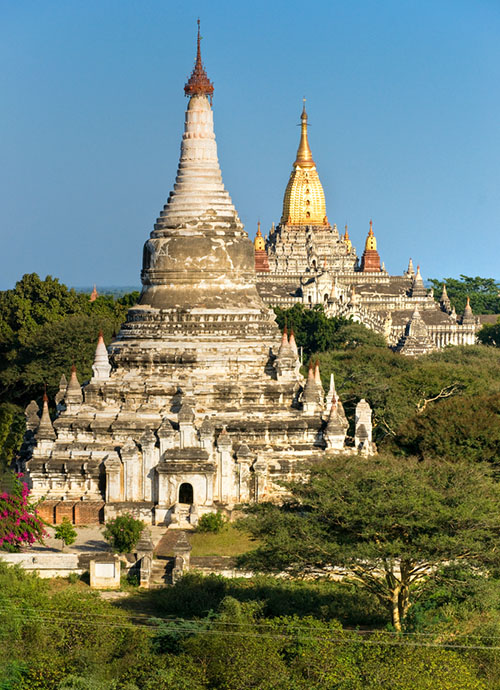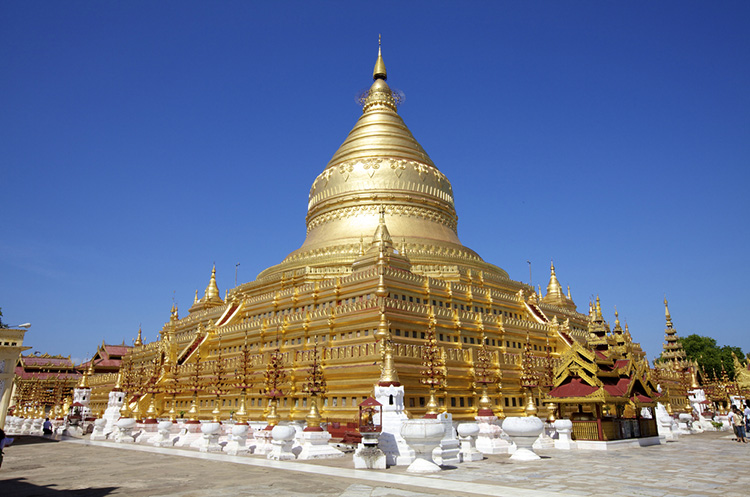
The history of the Bagan empire
Rise and fall of one of Asia’s most powerful empires
The Bagan archaeological zone is one of the largest and most important historical sites in South East Asia. It is located in the dry zone of Central Burma, on the East bank of the Irrawaddy river.
Founding of Bagan in 1044
Settlement of the Bagan area most likely started halfway the 9th century. Over the next two centuries settled area gradually extended until in the year 1044 King Anawrahta founded the Bagan Kingdom. At that time the Kingdom included still a relatively small area where people were mainly involved in farming.
As Bagan is located in the dry zone of Burma, the area receives little rain and is dependent on irrigation for farming. The Bagan people managed to develop and improve water management systems to irrigate the land. They built a system of dams, waterways and sluices which enabled them to cultivate dry land and turn it into farmland. This ability allowed them to expand into the dry desert like area, which attracted more people, thus expanding the Kingdom.
King Anawrahta’s conversion to Buddhism
At that time Buddhism did not yet play an important role in the country. King Anawrahta was converted to Theravada Buddhism by a monk named Shin Arahan from the Thaton Kingdom, one of the Mon Kingdoms that existed in Burma at the time. The King decided to spread Buddhism and started a massive campaign to build thousands of Buddhist temples, pagodas and other monuments.
Invasion of the Thaton Kingdom
In the year 1057 King Anawrahta invaded the Thaton Kingdom. After the invasion the Tripitaka, the sacred Buddhist scriptures containing the teachings of the Buddha were brought back to Bagan.
A large number of architects, builders and artisans from Thaton were also brought over to Bagan, who worked on the design and construction of thousands of Buddhist temples and pagodas.
This was the time that the temple building began on a massive scale. Much of the empire’s wealth was used towards construction of Buddhist monuments. King Anawrahta who ruled Bagan from 1044 until 1077 had a number of impressive temples built, including the Shwezigon pagoda and the Shwesandaw pagoda.

Expansion of the empire and massive temple building
Over the next centuries thousands of temples and pagoda were built by Royals as well as prosperous inhabitants of the city in order to gain religious merit. Bagan became an important center for Theravada Buddhism and study and attracted monks from far away countries. More than 10,000 temples and monuments were built at the height of the Kingdom’s power between the 11th and 13th century.
King Anawrahta’s successors further expanded the Kingdom; according to several sources the empire reached as far as parts of present day Thailand.
The empire experienced prosperous times, mainly based on agriculture. During the Kingdom’s most powerful period from the end of the 12th century until mid 13th century, Bagan had up to 2 million inhabitants. At that time Bagan and the Khmer empire of present day Cambodia were the most powerful empires in South East Asia.
End of the empire
Because so much fertile land was used towards construction of temples and pagodas, farm land was becoming scarce during the 13th century, which posed a threat to the Kingdom’s wealth.
Invasion by Mongol armies
Towards the end of the 13th century Bagan was invaded several times by the Mongol armies led by Kublai Khan, the Great Khan of the Mongol empire who reigned from 1260 until 1294. Another invasion in 1297 finally led to the end of the Bagan empire.
Bagan deserted
After the 15th century Bagan was mostly deserted and most temples fell into disrepair. The town was still a destination for pilgrimage, but the number of temples that was maintained well was limited to some of the most famous temples such as the Ananda and the Shwezigon.
Present day Bagan
Of the well over 10,000 monuments built some 2,200 remain today. The structures still standing are built of brick, while the wooden buildings like the Palace and the houses have not survived. The remaining temples and pagodas are in various states of repair, some very well maintained and restored, while others are neglected and overgrown with vegetation.
UNESCO has placed the Bagan archaeological zone on its tentative list for consideration as a future World Heritage Site.
Temples in Bagan
Among the temples & pagodas in Bagan are:
- Shwezigon pagoda
- Ananda pagoda
- Gawdawpalin temple
- Sulamani temple
- Thatbyinnyu temple
- Seinnyet sister temples
- Bupaya pagoda
- Mahabodhi temple
- Htilominlo temple
- Mingalazedi pagoda
- Dhammayazika pagoda
- Dhammayangyi temple
- Lawkananda pagoda
- Manuha temple
- Pyathadar temple
- Pahtothamya temple
- Myazedi pagoda
- Shwesandaw pagoda
- Gubyaukgyi temple
How to get to Bagan and how to get around
- Shwezigon pagoda
- Ananda pagoda
- Gawdawpalin temple
- Sulamani temple
- Thatbyinnyu temple
- Seinnyet sister temples
- Bupaya pagoda
- Mahabodhi temple
- Htilominlo temple
- Mingalazedi pagoda
- Dhammayazika pagoda
- Dhammayangyi temple
- Lawkananda pagoda
- Manuha temple
- Pyathadar temple
- Pahtothamya temple
- Myazedi pagoda
- Shwesandaw pagoda
- Gubyaukgyi temple